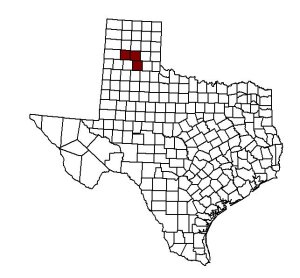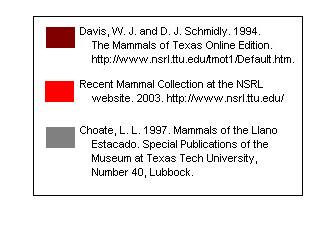 |
 Map prepared by Greg T. Lewellen |
Peromyscus truei comanche (Palo Duro Mouse)
Written by
Greg T. Lewellen (Mammalogy
Lab--Fall 2003)
Edited by Karah Gallagher and Jennifer Bailey
 |
 Map prepared by Greg T. Lewellen |
Peromyscus truei comanche is one of 15 subspecies of the Peromyscus truei group (Hoffmeister 1981). The geographic range of the entire Peromsycus truei group is from the Sierra Madre south to Oaxaca and Baja California of Mexico, northward to the southwestern United States (Hoffmeister 1951). Distribution of the Peromyscus truei group within the United States includes north to central Oregon and southern Wyoming (Hoffmeister 1951), east to eastern Colorado (Armstrong 1972), and western Oklahoma (Hoffmeister 1951), and west to the Pacific Ocean (Hoffmeister 1951).
Distribution of the subspecies Peromyscus truei comanche is limited to the panhandle of Texas (Blair 1943; Schmidly 1973; Choate, 1997). Within the Texas panhandle, distribution is limited to 7 counties: Randall, Armstrong, Briscoe, Dickens, Garza, Lynn and Swisher (Blair 1943; Schmidly 1973; Johnson and Packard 1974; Zimmerman and DeWalt 1990; Choate et al. 1991; Choate 1997). Distribution in counties south of Briscoe County, however, is controversial (Choate 1991; Yancey et al. 1996). The most continuous range is the northern, 3-county area of Randall, Armstrong and Briscoe counties, with distribution primarily along the eastern escarpment of the Llano Estacado (Zimmerman and DeWalt 1990; Yancey et al. 1996; Choate 1997). Peromyscus truei comanche is geographically isolated by approximately 120 km of uninhabitable land from the populations of P. truei truei in the far northwestern corner of the Texas panhandle (Blair 1950; Yancey et al. 1996).
Physical Characteristics:
The members of the P. truei species group are large-eared, medium sized mice (Hoffmeister 1981). The dorsal tail stripe is slightly darker than the back, and the tail is covered with short hairs (Dice 1952; Hoffmeister 1981). Greatest skull length in adults is usually 27.0 to 30.0 mm (Hoffmeister 1981).
Peromyscus truei comanche differs from P. truei truei in that the ears and auditory bullae are smaller, tail length is longer and the ratio of tail length to body length is greater than 1.0 instead of less (Schmidly 1973). External measurements of a single adult female from Blair (1943) are as follows: total length, 206; tail, 107; hind foot, 22.0 and ear from notch 21.0. Pelage color from the type single adult female is described as dorsally ochraceous buff mixed with dusky; a pronounced lateral line of ochraceous buff unmixed with dusky; tail more or less sharply bicolor and feet and underside white (Blair 1943). This type specimen (Blair 1943) was used by Schimdly (1973) in the description of the group as a subspecies of the P. truei group rather than a separate species as described by Blair (1943).
Further differentiation of the Palo Duro mouse from similar species includes comparisons to the Texas mouse (Peromyscus attwateri) by Schmidly (1973). The difference is as follows: the hind foot of the Palo Duro mouse is shorter than the Texas mouse; the length of the ear of the Palo Duro mouse is longer than that of the Texas mouse and chromosomally, The Palo Duro mouse has 5 pairs of large biarmed autosomes instead of the 3 of the Texas mouse.
Natural History:
Food Habits: The food preference of P. truei may vary depending upon the season (Bradford 1974). The stomach contents of 16 mice taken in midsummer were examined in a study by Bradford (1974). The contents consisted primarily of insects and some spiders, while one contained 60% mammal remains. The diet changed towards late summer, with acorn mast the dominant content. The winter diet of P. truei is primarily juniper seeds (Juniperus spp.), as these are the dominant seed source during this time in the habitats occupied by numerous subspecies (Douglas 1969).
Specific food studies have not been performed on the Palo Duro mouse, although several sources list possible foot habits (Zimmerman and DeWalt 1990; Yancey et al. 1996). The Palo Duro mouse is suggested to consume juniper, mesquite (Prosopis glandulosa) and prickly pear seeds (Opuntia spp.; Zimmerman and DeWalt 1990). There is suggestion that diet may play an important role in limiting distribution of this subspecies (Yancey et al. 1996).
Reproduction: The reproductive biology of the Palo Duro mouse is not well studied, with only one report published (Yancey et al. 1996). Evidence suggests that members of the genus Peromyscus breed whenever environmental conditions are suitable for rearing of young (Millar 1989). For the Palo Duro mouse, this period apparently occurs between mid-March and early October (Yancey et al. 1996). The available data for reproduction comes from 42 specimens collected by Yancey et al. (1996) and from specimens housed at The Museum at Texas Tech University. Gravid females were taken during April, June, July and August. Zimmerman and DeWalt (1990) report gravid females in March and October.
Behavior: Members of the P. truei group are noctural, and seasonal and monthly variation exists in activity levels (Scheibe 1984). During the spring, female activity is overall greater than that of males. Fall and winter activity levels are positively correlated with ambient temperature, and fall activity is negatively correlated with moonlight. The intensity of moonlight is correlated with activity level in fall, and somewhat during the winter, while spring and summer activity is not affected by moonlight intensity. Cloud cover and wind speed were only slightly correlated with rodent activity during spring and summer. There have been no behavioral studies that directly relate to the Palo Duro mouse.
Habitat: The Palo Duro mouse is historically described as inhabiting the “Break of the Plains” in escarpment canyons such as Palo Duro Canyon and Tule Canyon (Schmidly 1973). The most common habitat structure associated with the Palo Duro mouse is the presence of large boulders and rocky situations (Tamsitt 1958; Zimmerman and DeWalt 1990; Yancey et al. 1996). The presence of juniper scrubland is also associated with Palo Duro mouse habitat (Tamsitt 1958; Zimmerman and DeWalt 1990; Yancey et al. 1996). Specifically, Yancey (1996) reports that 64% of the 27 Palo Duro mice captured during the study were taken on sparsely-vegetated, juniper-clad, steep rocky slopes of red sandstone, locations often referred to as Spanish skirts. Zimmerman and Dewalt (1990) report that the Palo Duro mouse spends a great deal of time on the canyon floor and in very low, rocky situations near prickly pear cactus. Also noted is the possibility that the Texas mouse and the Palo Duro mouse compete for space and/or food (Zimmerman and DeWalt 1990; Yancey et al. 1996). A general synopsis of habitat studies indicates that the Palo Duro mouse can be found primarily in association with steep, rocky escarpment slopes that are sparsely vegetated. Vegetation associations may include juniper-mesquite scrublands along the escarpment and mesquite-prickly pear cactus scrublands in the floodplains. Palo Duro mice may travel substantial distances during the night to forage, from the steep escarpment slopes down to the floodplains in search of food (Zimmerman and DeWalt 1990). Nesting locations for Palo Duro mice have been reported as rocky refugia similar to white-throated woodrat (Neotoma albigula) middens and beneath prickly pear cactus (Zimmerman and DeWalt 1990).
Economic Importance for Humans:
There is no direct economic use or importance of the Palo Duro mouse.
Conservation Status:
Because of its limited distribution, the Palo Duro mouse has been listed by the Texas Parks and Wildlife Department as a threatened (protected nongame) species within the state of Texas. The Palo Duro mouse is also a candidate for Category 2 listing by the U.S. Fish and Wildlife Service under the Endangered Species Act of 1974. At the present time, there are no significant threats to the specific habitat that the Palo Duro mouse inhabits, with most of this habitat having no agricultural value and occurring within two state parks (Yancey et al. 1996). The current knowledge about the Palo Duro mouse is lacking in important areas, including food habits, the effects of competition with the Texas mouse and other congeneric and transgeneric species and data about parasites and diseases carried by Palo Duro mice. Also, the general ecological relationships between Palo Duro mice and other taxa, as well as with the vegetation and environment, are in need of study.
References:
Armstrong, D. M. 1972. Distribution of Mammals in Colorado. Monograph of the Museum of Natural History, The University of Kansas, No. 3. University of Kansas Press, Lawrence.
Blair, W. F. 1943. Biological and morphological distinctness of a previously undescribed species of the Peromyscus truei group from Texas. Contributions of the Laboratory for Vertebrate Biology, University of Michigan, Ann Arbor 24:1-8.
Blair, W. F. 1950. Ecological factors in speciation of Peromyscus. Evolution 4:253-275.
Bradford, D. F. 1974. Water stress of free-living Peromyscus truei. Ecology 55:1407-1414.
Choate, L. L. 1997. Mammals of the Llano Estacado. Special Publications of the Museum of Texas Tech University, Number 40, Lubbock.
Choate, L. L., R. W. Manning, J. K. Jones, Jr., C. Jones and T. R. Molhagen. 1991.Records of mammals from the Llano Estacado and adjacent areas of Texas and New Mexico. Occasional Papers, The Museum at Texas Tech University, Lubbock 138:1-11.
Dice, L. R. 1952. Variation in body dimensions and pelage color of certain laboratory-bred stocks of the Peromyscus truei group. Contributions from the Laboratory of Vertebrate Biology, University of Michigan 47:1-26.
Douglas, C. L. 1969. Comparative ecology of pinyon mice and deer mice in Mesa Verde National Park, Colorado. Publication of the Museum of Natural History, University of Kansas Press, Lawerence 18:421-504.
Hoffmeister, D. F. 1981. Peromyscus truei. Mammalian Species 161:1-5.
Hoffmeister, D. F. 1951. A taxonomic and evolutionary study of the piñon mouse,Peromyscus truei. Illinois Biological Monographs 21:1-104.
Johnson, G. L., and R. L. Packard. 1974. Electrophoretic analysis of Peromyscus comanche Blair, with comments on its systematic status. Occasional Papers, TheMuseum at Texas Tech University, Lubbock 24:1-16.
Millar, J. S. 1989. Reproduction and development. Pp. 169-232 In Advances in the study of Peromyscus (Rodentia), G. L. Kirland and J. N. Layne, eds. Texas Tech University Press, Lubbock.
Scheibe, J. S. 1984. The effects of weather, sex and season on the nocturnal activity of Peromyscus truei (Rodentia). Southwestern Naturalist 29:1-5.
Schmidly, D. J. 1973. The systematic status of Peromyscus comanche. Southwestern Naturalist 18:269-278.
Tamsitt, J. R. 1958. Abundance of the Palo Duro mouse, Peromyscus comanche during 1949-1956. Southwestern Naturalist 3:234-236.
Yancey, F. D. III, R. W. Manning, and C. Jones. 1996. Distribution, natural history and status of the Palo Duro mouse, Peromyscus truei comanche, in Texas. Texas Journal of Science 48:3-12.
Zimmerman, E. G., and T. S. DeWalt. 1990. Status of the threatened Palo Duromouse, Peromyscus truei comanche, in Texas. Report submitted to Resource Protection Division, Texas Parks and Wildlife Department, Austin.